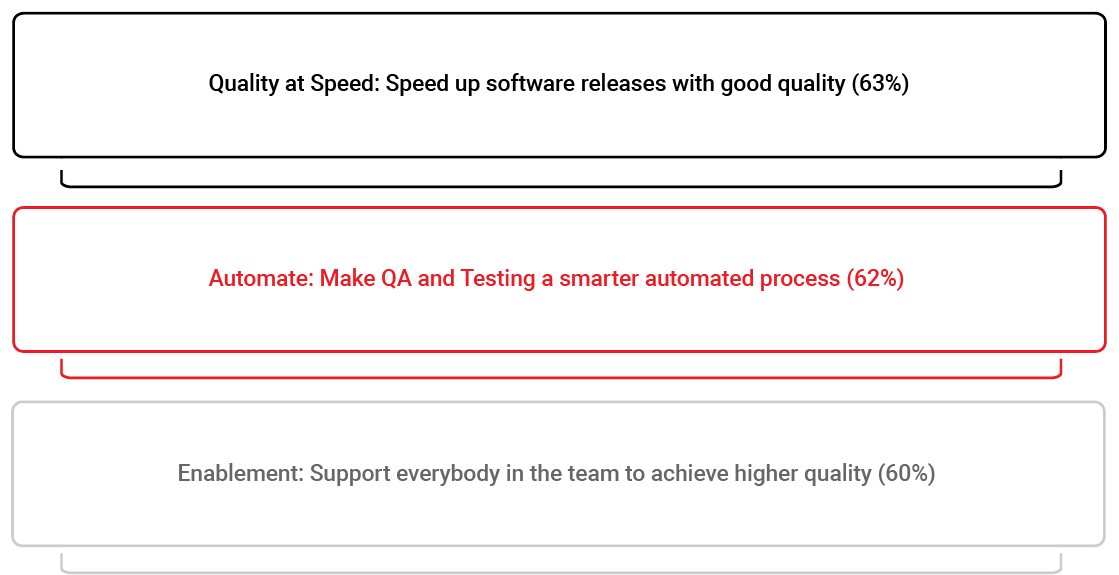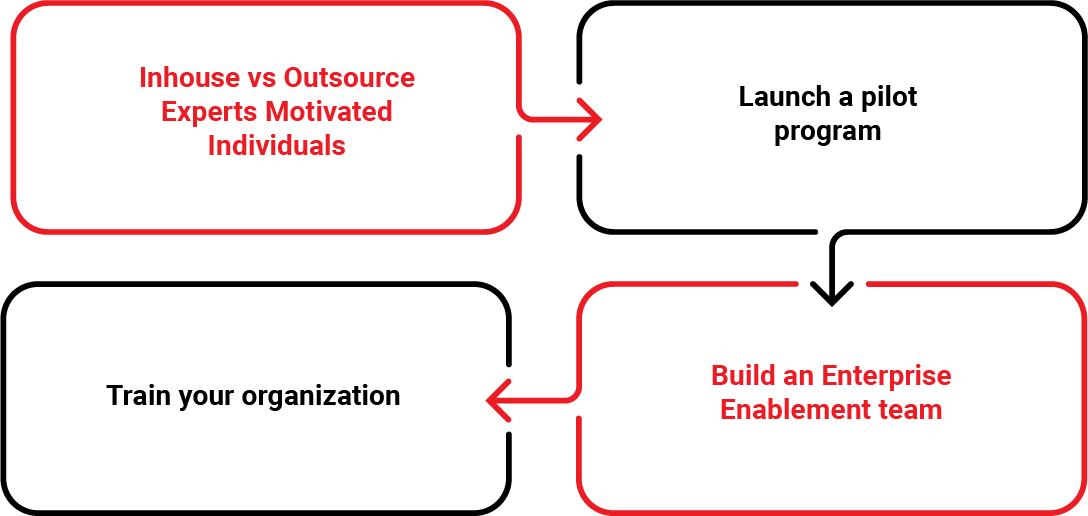Continuous Testing is a critical component of the Continuous Delivery ecosystem, enabling faster delivery from design to production without sacrificing any quality parameters. By facilitating it, organizations can achieve Continuous Delivery.
It aims to “Shift Left” and avoid putting the burden and risk on production by starting testing on day one of the software development life cycle. By identifying defects early, it allows for the release of higher quality and more scalable software at a quicker pace.
Benefits of Continuous Testing Framework

Steps to Design Continuous Testing Framework
Step 1: Establishing a Testing Strategy Framework & Baseline
Your vision of what future pipeline of upcoming applications will guide you through the process of modernizing your testing organization. This will match your application plan vision. That’s why it’s essential to get it right.
- Envision the plan over short term and long term. Approach the process of writing a vision as a chance to create your ideal world for QA and testing. Aim high and in case of probability you will be in a much better place, if you have constraints of manpower or budget.
- Short, Crisp, and Clear. Communicating your vision to your audience needs to capture attention, inspire action, and is short enough for others to remember so that they can communicate further.
- Engage stakeholders. No stakeholders should feel left out of the process of writing your short term and long-term plans. This will make the journey smooth when key interdepartmental stakeholders are required to sign off.
Step 2: Define The Strategy
Identify the Right People
The success of your testing transformation heavily relies on people. Therefore, it is crucial to identify your key players before initiating any changes. Third party experts can guide you to the right team in place. Map out career paths for identified people and plan how you’ll train and educate them on how to carry out your plan.
Define the Test Strategy
Identify the right continuous testing processes. If you’re going with an agile approach, you’ll need to align your agile testing cycle with the development methodologies – SAFe, LeSS, Spotify, or Scrum.
Align your testing cycle with your development methodology, define testing responsibilities, and match your test strategy with the right tools that support your critical capabilities and technical skills while being easy to integrate and use. (e.g SAFe, LeSS, Spotify, or Scrum).
Choose the Operating Model
Consider how your testing organization will actually run.
Calculate the Business Case
ROI calculation for test strategy is crucial to communicate the importance of investing in testing, with potential benefits including increased speed to market, reduced risk, and greater cost efficiency.
Step 3: Assemble a Team of Motivated Individuals
Here is where you begin to line up your team of people who not only have the talent to help you, but also the motivation and enthusiasm to get started right now. Follow these steps:
Step 4: Establish the Testing Infrastructure
The teams will not take action and set up the processes and tools that will form the foundation of the end enterprise testing program.
Set up the Testing Infrastructure
Automate repetitive tasks by activating automation, virtualization, testing, and test data management tools. Integrate these tools into your development and deployment pipeline.
Sustainability with Documented Service Catalog
Creating a catalog of your testing activities can help make your testing program sustainable. By documenting all tasks, they can become standardized services that are available to any department.
Document and Exchange Best Practices
To build a robust continuous testing framework, foster a culture of learning. Share your learnings and success stories with other teams in the organization. Consider creating communities of practice to facilitate knowledge-sharing.
Step 5: Empower Teams to Be Self-Governed to Excellence (Scale)
Here the testing team learning curve is evolved and the team focus is delivering excellence. While all upcoming pilot Testing projects can learn rapidly from this team delivering success from accelerated change management. Here are few actions one can take:
Onboard New Teams / New Project / New Applications
Established guidelines and tools will be shared with all existing and upcoming testing projects/teams. Potential ROI impact, and value will help determine why and how the new teams are brought onboard. Same mindset is applied for new applications that are required. e.g CRM solution and lack expertise in the department that’s implementing it, you could assign to new members.
Enable Teams
Leverage existing tools properly, work within the delivery pipeline, and interpret the vast amounts of data they’ll encounter during testing.
Streamline Quality
Whether inhouse or outsourced to a specialist partner all teams must implement the organizational testing strategy correctly. This step includes making sure your continuous testing strategy is integrated into your organization.
You’ll know your testing program is maintaining an appropriate level of quality as it scales when you see greater risk coverage, lower maintenance, faster implementation, higher productivity and higher automation rates.
Step 6: Deliver Meaningful Insights / Performance Metrics
Without measuring performance and using insights, the testing program can’t be on track unless and until your decisions go haywire as you seek to enhance it. Assess the business risk of product defects and the impact of the continuous testing framework and strategy
Step 7: Improve Performance and Productivity with Automation
A testing organization that continues to innovate is an organization that will continue to improve. Every organization should integrate innovation into its lifecycle.
Develop an Automation Strategy
Repetitive testing practices should be Automation. It helps eliminate delays and accelerates innovation. Team members become free and they are involved in spending more time adding value. Create a culture of adding value, and share ideas. There’s no such thing as a bad idea brought to the table
Assess and Improve
It’s essential for the organization to understand that pursuing technical excellence isn’t just about teaching and enforcing standards—it’s also about listening and iterating. Teams across the organization have valuable perspectives on the software delivery pipeline. These perspectives can benefit everyone in the organization—from business users to developers and testers! The best way to gather these insights is in regularly scheduled sessions organized by the EE team. EE teams should use these insights to inspire their continuous innovation.




